XenonZcar.com - VG33ET Swap, What it takes to build a Turbo 3.3L VG
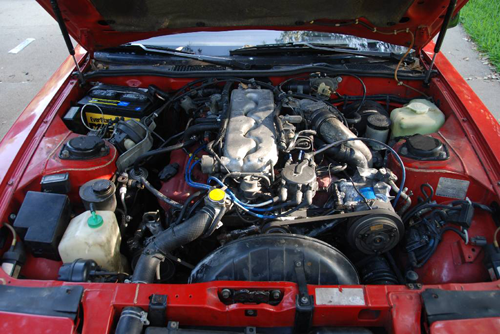
As many of you heard the saying "there is no substute for displacement" the VG33E is a largest displacement version of the VG series motors. They are found in the following USDM vehicles:
- '96-'00 Nissan Pathfinder
- '97-'00 infinity QX4
- '99-'04 Nissan Frontier, '01-'04 supercharged avaliable
- '99-'02 Nissan Quest & Mercury villager
- '00-'04 Nissan Xterra, '01-'04 supercharged avaliable
VG33E Basics
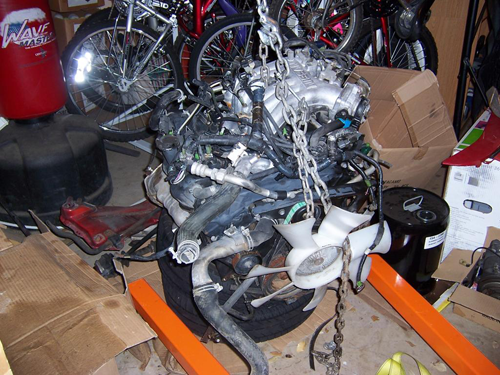
The VG33E motors found in these vehicles are identical to a VG30E with the exception of a few minor external components. There are mostly minor location differences of components, routing of lines, and electronic components that visually set the VG33E apart, though these minor differences can be worked around by using parts from other VG Series motors.
Basic information, intake manifold down to the heads:
Getting a little more in depth lets talk about the intake and fuel related pieces, the VG33E uses the upper intake manifold found on earlier pathfinders and quest that used the VG30E. The lower intake manifold is similar to the VG30E's as well being able to use most of the 3.0's upper intake manifolds, the coolant neck found on the 3.3's lower intake houses two sensors though it is similar to some of the 3.0's does not function as a filling location like some 3.0 designs, but it shares the same flange design and bolt pattern so it is able to use many variations. The fuel system is similar to the later +'87 3.0's using side feed injectors, though the seals are of larger diameter and different design. The injector design found on the 3.3's are junk and impossible to find high flow rate injectors for, you might as well junk them. The locations to bolt the fuel injectors down is much lower on the 3.3's lower intake manifold, other differences are the 3.3's intake manifold lacks a sensor and coolant tube on the rear passenger side some of the 3.0's used, the rear coolant tube has different routing than most 3.0's, again the flange and bolt pattern is similar to the 3.0's so swapping tubes is simple. Port diameters (~36mm) are similar as well as head to manifold coolant passages, and will line up with any VG30 head casting.
The heads specific to the 3.3 are known by casting reference "OWO". Visually they are very similar to the 3.0's head using 13 head bolts, the main difference being the 10mm exhaust studs. The exhaust studs can easily be rearranged to suit your header choice using a TORX socket.
Internally they share parts with the 3.0 specifically the rockers, lifters, lifter guide, valve and valve spring locks, retainers, valve stem diameter, height, and ultimately - layout. The 3.3's valves can be identified by their casting "EF-3". The valve stem diameters, guide diameters, and seat angles are the same between the 3.3 and 3.0. Both the intake and exhaust ports have a much smoother casting than the 3.0's V52, 21V, and 85E heads. Head bolt locations, water passages, and oil galleys are similar though there are slight differences in the water passages they will not interfere with swapping 3.3/3.0 heads to ether block though I would advise against 85E or 21V heads onto a 3.3 block due to the water passage being close to the combustion chamber more so than the V52. A major difference is in the camshaft found in the 3.3, the 240/244 .354"/.354" cam is good for low end grunt but not that great for high RPM power. The 3.3's camshaft is commonly swapped out for 3.0's camshafts for better high RPM performance, aftermarket 3.0 cams will also work. Another difference that is very important to note is the camshaft sprockets, the 3.3's sprockets use a round tooth style compared to the 3.0's more squared tooth style, the matching crank gear must be used.
Basic information, bottom end and rotating assembly:
Lets start with the engine block. Again the 3.3's block can be identified by an "OWO" casting on the front driver side. Many of the locations to bolt up engine brackets, and accessory brackets are pre*drilled and tapped making the use of other 3.0 pieces an easy affair. The block to bell housing pattern is also the same as 3.0's making many transmissions available. What makes the 3.3 a 3.3 is the bore of 91.5mm, the stroke length is shared with the 3.0 at 83mm. The pistons are cast like other VG's having a compression ratio of 9:1 they also have the OWO imprint along with valve reliefs and a slight bowl to the center. The connecting rods, again stamped with "OWO" are similar to a 3.0's the difference being the notches at the bottom. The 3.3 rods are also similar to the later 3.0's floating wrist pins found in the "W" series engines.
The crankshaft is cast sharing the same main and connecting rod journal sizing system as the 3.0's, it also shares the six bolt flywheel pattern found on 3.0's. The major difference between the 3.3's and 3.0's crankshaft is the snout, the 3.3's has a larger diameter and must be used with the matching 3.3 oil pump and pulley. The 3.3's oil pump also is the mounting location for the oil filter and oil pressure sensor, the pumps pickup is also closer to the center line and has a taller mounting location than 3.0's pick up location this may require modifying the oil pan per-application. A common discussion is drilling the block for an oil feed location when adding a turbo, the motor I picked up from a '96 Pathfinder did not require any drilling as it only has a plug. The oil filter location was rumored to not clear when mounted in a Z31, my set up with a 1" antiswaybar, z31parts.com poly engine mounts, and intact power steering lines clears with plenty of room for a larger filter.
Accessories:
The 3.3's crankshaft pulley is delicate, and prone to chipping/cracking use caution when removing and handling.
The 3.3's pulley is special, it has a 32mm center bore, and has variations in belt style and routing per-model. The easiest way to over come this issue is to keep or get the associated brackets and accessories the come with the engine, though this may interfere with simple intake and intercooler pipe routing on those who choose to use turbochargers. There is also the option to swap in a 3.0 crank and use the 3.0 pulley and accessories this also involves using the 3.0 oil pump and using the Quest style 3.0's oil pump that side mounts the oil filter like the 3.3's, or simply using the 3.0's oil filter stud from other variations to relocate the filter.
The Swap
In this Example we will be swapping the VG33E crank for the VG30ET Crank. This is the easiest way of completing this swap as the VG33E crank has a larger snout and will only work with the VG33E Oil pump and oil pan that would need Fabrication to work in the Z31. This Includes Fabricating an Oil Pump Pickup tube and removing part of the oil pan baffle to clear the modified tube. By swapping over to the Z31 VG30E (t) components you can use the Z31 pan and oil pump as well as the timing gears and pulleys.
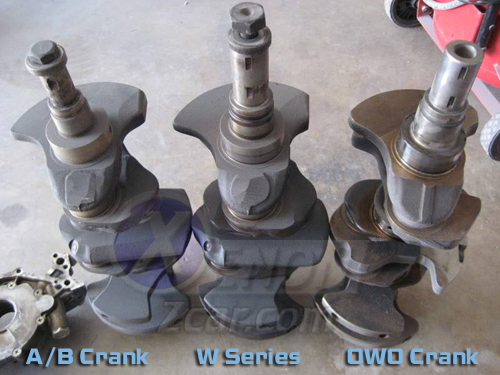
Note the Size of the crank snout on each of the different Crankshafts. OWO has the largest diameter at 32mm where the A/B and W series have a 28mm snout.
Below you will see the steps in fabricating an Oil pump pickup tube from two pickup tubes.
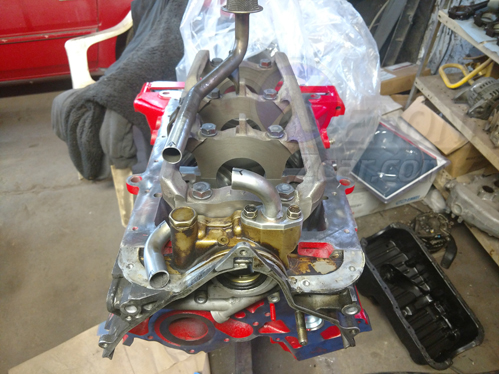
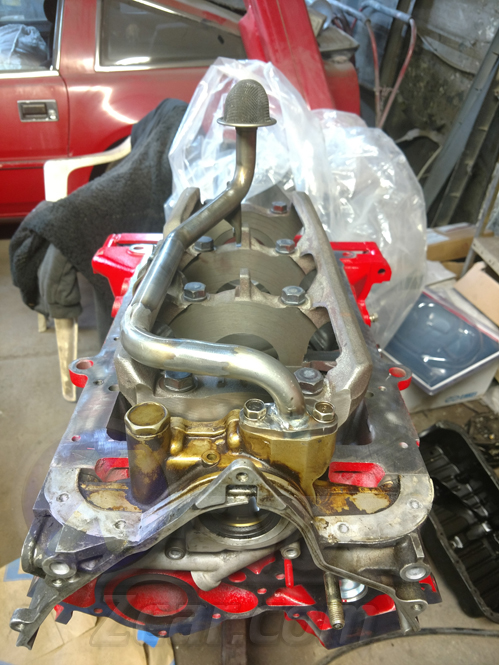
Parts Needed
- Clutch (makes sense, you will have more power then a stock clutch can handle at this point and much better off doing it while you have easy access
- Gasket kit (get a VG33 gasket kit, I got mine from ebay)
- Front main seal for a VG30 (the VG33 front main seal won?t fit the VG30 crank)
- Main bearings (you are changing the cranks, of course you need this)
- Rod bearings (ditto above)
- assembly lube (You need to make sure you lube ALL metal on metal surfaces on the engine when putting it back together, use haynes manual or FSM for locations)
- VG30 Water pump (must use a VG30 water pump with a VG30 crank)
- VG30 timing belt - Nissan part#13028-16E85 (must use a timing belt for a VG30 with a VG30 crank, PS, the belts changed in the 90?s, so make sure you get a belt that is the same year as your parts engine)
- VG30 timing belt tensioner - Nissan part#13070-42L00 (need to replace this while in there and it also has to match the crank)
- Black RTV sealent, (need this for various places, the oil pan for one thing)
- New spark plugs: NGK Part # 6953 More Info {V-Power Plug #BKR5E11} Plugs - SOHC {.039 gap} 2.00 a piece on rockauto.com. (well this is common sense, why use old plugs when they only cost $2?)
- Oil filter stud - Nissan Part# 15213-21001 (will need this to install an oil filter, slightly important)
- Oil filter Relief valve - Nissan Part# 15241-40F00 (ditto above)
Special Tools Needed
Total costs
The best case for the total cost for this swap will be about $1250 - $1750, But the simple fact is things never go to plan, so real best case number I would put more in the $1500 - $2000 range. Then you have to add anything else you will need on top of the above part to that number. Example, without even adding every little item I have spent over $3000 on my swap to do it right but that included a lot of other stuff non-engine related. So make sure you have the funds to finish what you start! But In the big picture it is a pretty cheap swap, for $1500 to get a nice low mileage engine with more power then stock and just as much reliability is a good deal IMO. Considering that when looking for a stock VG30ET engine they were going for $750 - $1250 for JUST the engine. Parts engines were going a LOT cheaper though FYI.
Tear Down
- Following the FSM or Haynes manuals remove your engine from your Z making sure you label all connections.
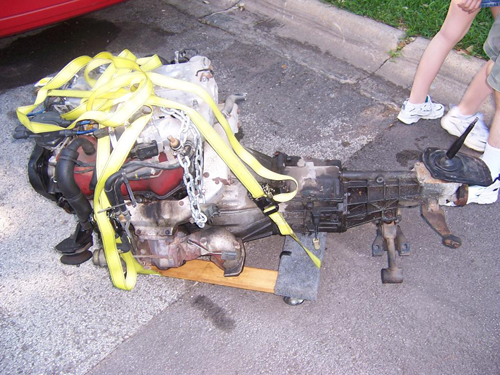
- Next remove the Intake, Exhaust manifolds from your VG30 and put them aside.
- Remove the distributor and valve covers from the VG30.
- Next Pull off all accessories that are still attached to the motor.
- Now remove the crank pulley being careful not to damage it. You will be reusing these parts so far.
- Once the crank pulley is off begin removing the timing belt covers and remove the timing belt and both Cam sprockets.
- Next pull off the upper timing inner cover and follow the Cam Removal process in the FSM to pull the VG30 Cams out.
- Now the fun part, Pulling off that crank timing gear. The easiest way to do this is to drill and tap 2 holes in the face of the gear. You will need to replace it of you do it this way but it is less likely to damage the crank and Oil pump housing.
- Now you can remove the Oil pump and pull it off the crank snout and off the motor.
- Flip the motor and pull the main bearing Cap making sure to mark where each bolt goes. Do the same with the Rod caps and nuts.
- Now you can remove the crank from the block.
- Repeat this with the VG33E motor as well.
Swapping parts
- Once you have both motors tore apart, start off by installing new bearings and swapping out the Crank from the VG30E (t) to the VG33 motor being careful not to damage or scratch the new bearing surfaces.
- Torque the Main bearing Bolts to 67 to 74 Ftlbs
- Torque the Rod cap Nuts in two stages. First stage is 10 - 12 Ftlbs, Second stage is either 60-65 Degrees more or if a angle gauge is not available tighten nuts to 28-33 Ftlbs of torque.
- Install the Z31 Oil pump onto the crank and install new front main seal. Now install a new Crank timing sprocket making sure both key-ways are inserted correctly.
- With the crank done you can Now install the oil pickup from the Z31 and install the oil pan from the Z as well.
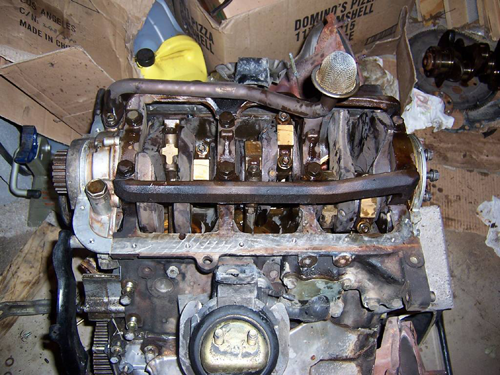
- With the bottom end done you can move on to Installing your VG30E(t) cams into the VG33E heads. Installation is the same as removal. Be sure to swap over the Distributor hold down bracket as the VG33 Distributor uses an angled bracket where the Z31 uses a flat bracket
- Now you will notice there is no location for the oil filter to screw into on the VG33 motor. This is where you will install the Oil filter stud and pressure valve into the block at the Z31 filter location. Be sure to use RED loctite when installing the stud into the new block.
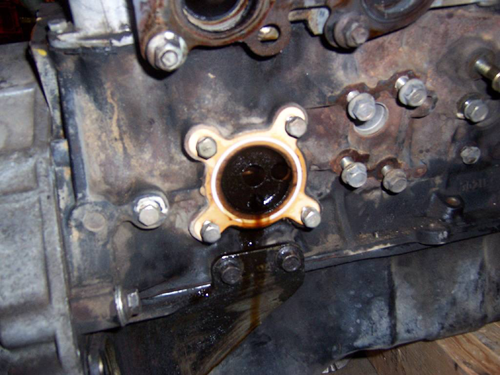
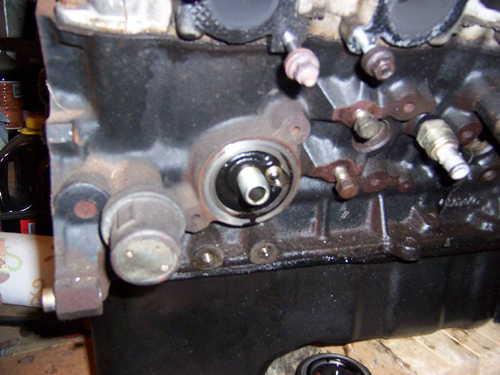
- Now I got to the intake (make sure you swap over the T-stat housing before doing the intake as you can't get to it after the intake is installed). I just took the complete lower/upper intake from the VG30 and moved it to the VG33, this way I didn't have to mess with the injectors or anything. Bolted right on.
- The last item that needs modification to work is the VG30E(t) Exhaust manifolds. This is because the VG33E motor uses 10mm exhaust studs and the VG30E(t) has 8mm studs. You will need to drill out the holes a little with a 1/2" bit. Be careful as the manifolds are cast and can crack.
- Other than that, It is a bolt in affair. Install all remaining components from the VG30E(t) motor and Install the motor into your Z.
Videos
|
Reference Material:
- 96 pathfinder FSM http://www.xenonz31.com/files/1996%20Pathfinder.zip
Sources used on this page:
- VG33 Basics written by: 88sinZ of Z31performance.com
- Swap Information and images by: Texas_Ace
